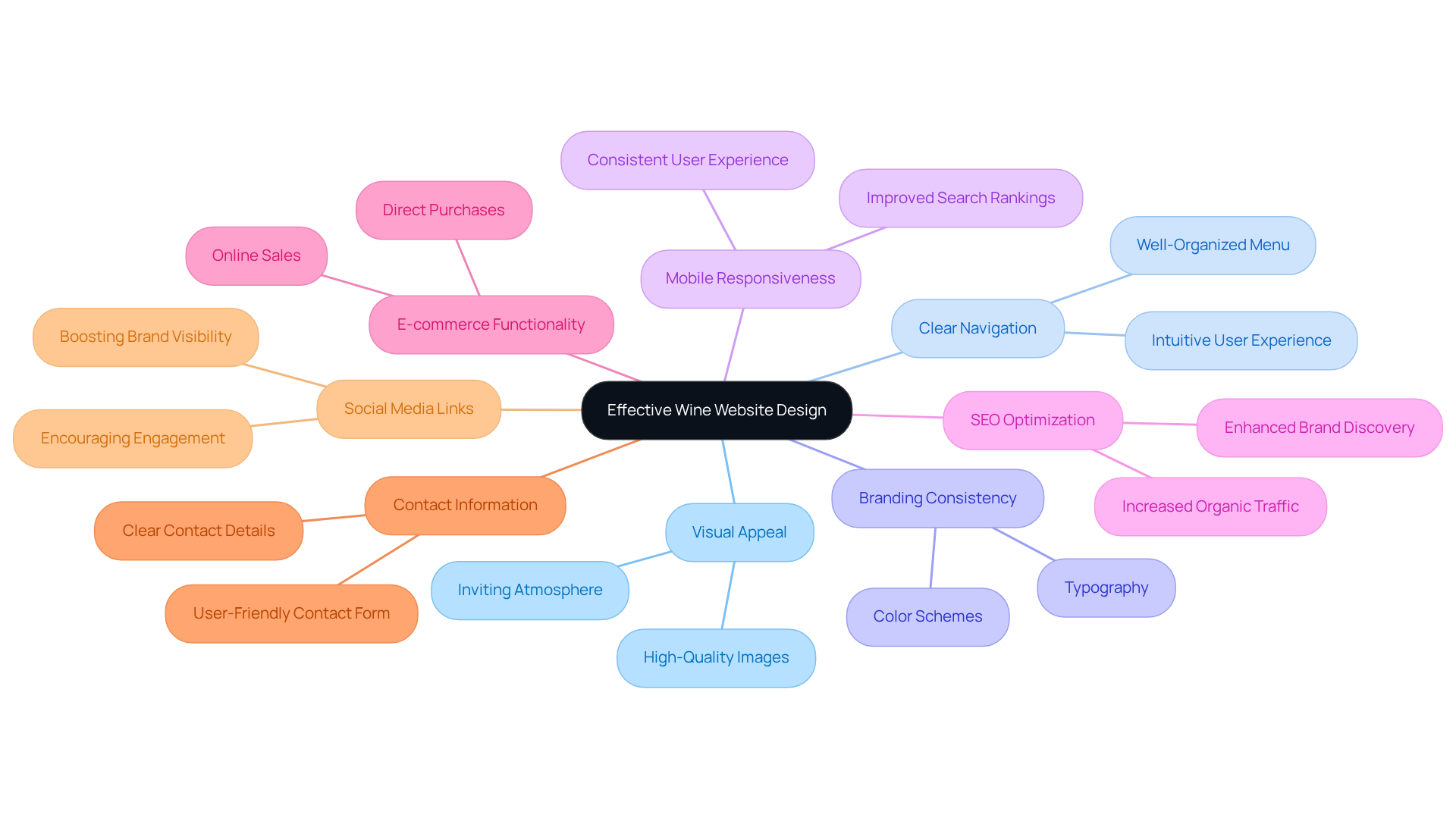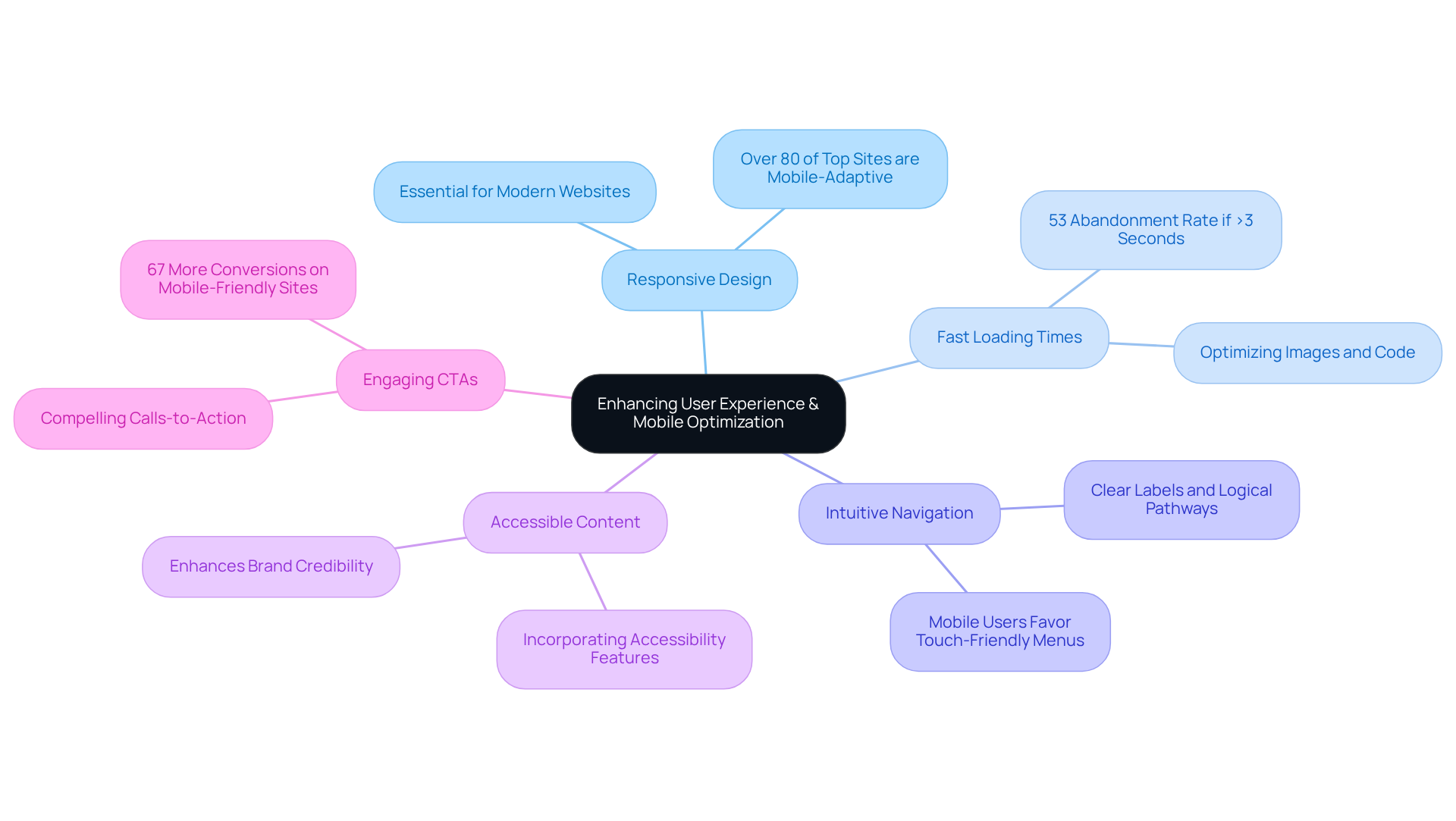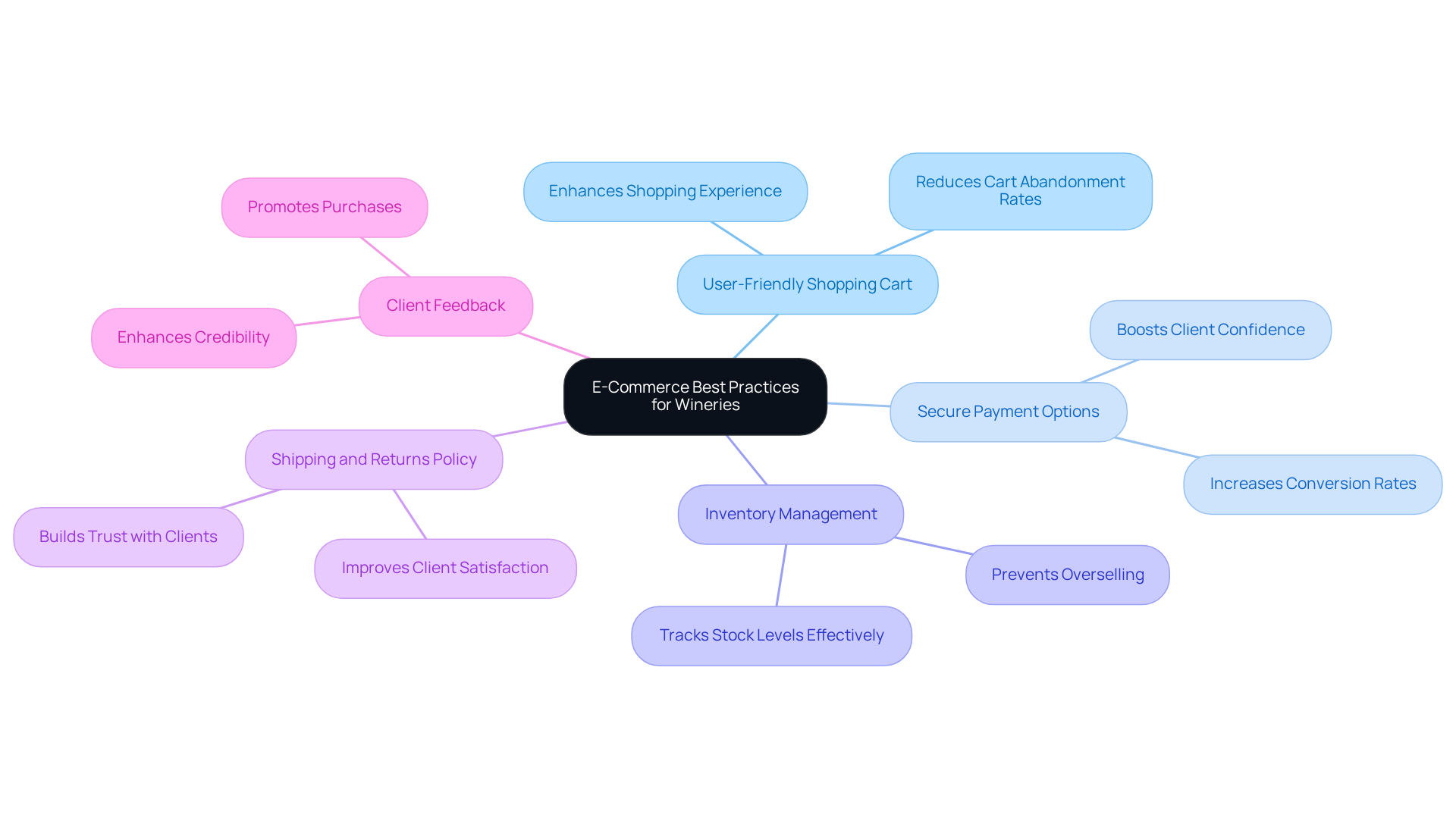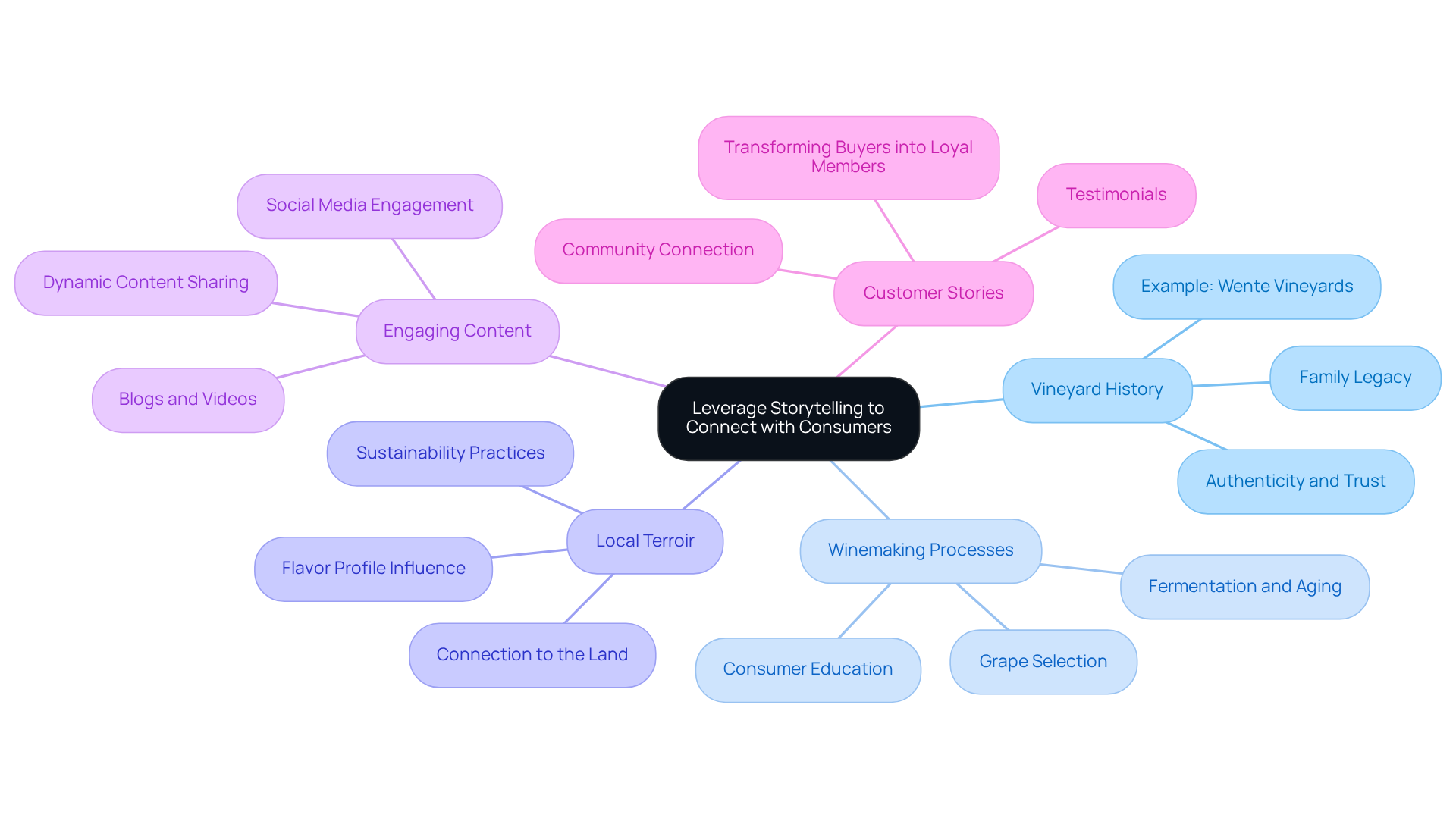Overview
Effective wine website design is paramount, centering on:
- Visual appeal
- Clear navigation
- Branding consistency
- Mobile responsiveness
- SEO optimization
These elements not only enhance user engagement but also elevate brand perception. Prioritizing these factors attracts visitors and encourages deeper exploration, fostering customer loyalty and ultimately supporting sustainable growth for wineries in the competitive direct-to-consumer market. By implementing these strategies, wineries can effectively navigate the complexities of the digital landscape and position themselves for success.
Introduction
Effective wine website design transcends mere aesthetics; it is the digital storefront for wineries aiming to forge connections with consumers and elevate their brand identity. By concentrating on essential elements such as visual appeal, intuitive navigation, and mobile responsiveness, wineries can cultivate an engaging online experience that not only draws visitors in but also nurtures loyalty. Yet, as the wine industry progresses, a pressing challenge persists: how can wineries seamlessly integrate e-commerce functionalities and compelling storytelling to distinguish themselves in a competitive market? This article delves into best practices that can revolutionize a winery's online presence, driving both sales and customer engagement.
Identify Key Elements of Effective Wine Website Design
Effective wine website design is crucial for enhancing user engagement and brand perception, particularly when transforming family-owned wineries into successful direct-to-consumer businesses. To achieve this, several essential elements must be prioritized:
- Visual Appeal: that showcase vineyards, wines, and tasting experiences are crucial for creating an inviting atmosphere. Striking visuals not only attract visitors but also evoke emotions that significantly influence purchasing decisions.
- Clear Navigation: A well-organized menu ensures that guests can effortlessly locate information about wines, events, and the establishment's narrative. Intuitive navigation is vital for a seamless user experience, enabling users to explore the site without frustration—an essential factor in converting casual buyers into loyal club members.
- Branding Consistency: Consistent use of color schemes, typography, and logo placement reinforces the establishment's identity. This coherence fosters trust and recognition among visitors, making the identity more memorable while enhancing the storytelling aspect of the winery's narrative.
- Mobile Responsiveness: With a significant portion of users browsing on mobile devices, responsive design is essential for providing a consistent user experience. Mobile optimization not only boosts usability but also elevates search engine rankings, facilitating easier discovery of the business online by potential clients.
- SEO Optimization: Implementing SEO best practices is crucial for increasing organic traffic to vineyard websites, thereby facilitating easier discovery and engagement with the brand's story.
- E-commerce Functionality: Strong e-commerce features are vital for vineyards, enabling online sales and allowing buyers to acquire wines directly from the site. This functionality is critical for generating predictable direct-to-consumer revenue, supporting strategic capital planning for future growth.
- Contact Information: Clear contact details and a user-friendly contact form enhance communication, making it easy for visitors to reach out with inquiries or feedback, further bolstering loyalty.
- Social Media Links: Incorporating social media buttons encourages visitors to engage with the establishment across various platforms, boosting brand visibility and interaction—essential for cultivating a devoted clientele.
By prioritizing these elements, vineyards can develop a wine website design that not only attracts visitors but also encourages deeper exploration and engagement, ultimately enhancing customer loyalty and supporting sustainable growth.

Enhance User Experience and Mobile Optimization
To enhance user experience and align with Enocap's strategic goals, wineries must prioritize the following best practices:
- Responsive Design: A website that seamlessly adapts to various screen sizes is crucial. This ensures a consistent experience across desktops, tablets, and smartphones. With over 80% of top-performing websites being , responsive design is not merely an option; it is essential for modern websites to maintain visibility and engagement, ultimately driving direct-to-consumer revenue.
- Fast Loading Times: It is imperative to optimize images and streamline code to minimize loading times. Research shows that 53% of mobile device owners abandon a site if it takes longer than 3 seconds to load. Speed is essential for retaining visitors and decreasing bounce rates, which is vital for converting casual buyers into devoted club members.
- Intuitive Navigation: Clear labels and logical pathways are necessary to guide visitors through the site. Streamlined navigation that avoids small text and endless dropdowns significantly improves user experience and boosts conversion rates. Mobile users particularly favor easy-to-navigate menus with touch-friendly buttons, enhancing Enocap's strategies for customer engagement.
- Accessible Content: Incorporating accessibility features, such as alt text for images and keyboard navigation, ensures all users can engage with the content. This inclusivity not only broadens the audience but also enhances brand credibility, aligning with Enocap's mission to craft stories that resonate with diverse consumers.
- Engaging CTAs: Compelling calls-to-action (CTAs) are essential in motivating visitors to sign up for newsletters, join wine clubs, or make purchases. Effective CTAs can significantly boost conversion rates; mobile-friendly websites see an average of 67% more conversions than their non-optimized counterparts. By enhancing these elements and utilizing effective wine website design, wine producers can drive growth and loyalty in the competitive wine e-commerce landscape, supported by Enocap's strategic capital advisory services.

Integrate E-Commerce Functionalities for Direct Sales
To effectively integrate e-commerce functionalities, wineries must prioritize several best practices in their wine website design to enhance their online presence and drive sales.
- User-Friendly Shopping Cart: A straightforward shopping cart is essential. It enables shoppers to easily add products and review their selections, thereby enhancing the overall shopping experience and reducing cart abandonment rates.
- Secure Payment Options: Offering a range of secure payment methods—such as credit cards, PayPal, and digital wallets—caters to various preferences. This flexibility not only boosts client confidence but also increases conversion rates.
- Inventory Management: Implementing robust inventory management tools allows wineries to track stock levels effectively. This prevents overselling and ensures that purchasers can buy available products without frustration.
- Shipping and Returns Policy: Clearly outlining shipping options and return policies builds trust with clients. Transparency in these areas significantly improves , as consumers increasingly favor companies that prioritize open communication.
- Client Feedback: Enabling client reviews and ratings for products enhances credibility and promotes purchases. Positive testimonials act as social proof, influencing potential buyers and fostering a sense of community around the brand.
By concentrating on these e-commerce features, vineyards can improve their wine website design to create a seamless shopping experience that not only encourages direct sales but also fosters long-term customer relationships. This approach aligns with Enocap's mission to unlock direct-to-consumer revenue and craft compelling narratives that resonate with consumers.

Leverage Storytelling to Connect with Consumers
Wineries have the potential to significantly enhance consumer engagement through effective storytelling by focusing on several key strategies:
- Sharing the Vineyard's History: Illuminate the origins of the vineyard, detailing the family legacy and the passion that fuels its operations. This connection fosters authenticity and trust among consumers. For instance, Wente Vineyards, the oldest continuously-operated, family-owned establishment in the U.S., effectively utilizes its family story to cultivate trust and authenticity, a practice that aligns with Enocap's strategic advisory services aimed at enhancing cash flow and DTC engagement.
- Showcasing Winemaking Processes: Offer insights into the intricate winemaking journey, from grape selection to fermentation and aging. Educating consumers about these processes not only informs but also enhances their appreciation for the product, reinforcing the brand story of the establishment. Enocap's market intelligence can assist vineyards in identifying the most compelling aspects of their winemaking processes to highlight.
- Highlighting Local Terroir: Emphasize the distinctive characteristics of the vineyard's location and how they shape the wine's flavor profile. This connection to the land enhances the narrative and appeals to consumers' , which is crucial for building long-lasting loyalty. Enocap's strategic capital planning can support wineries in promoting their unique terroir effectively.
- Engaging Content: Utilize blogs, videos, and social media platforms to share compelling stories about events, wine pairings, and client experiences. With 87% of buyers believing social media influences their shopping decisions, dynamic content keeps the audience engaged and encourages sharing, driving consistent growth in direct-to-consumer channels.
- Customer Stories: Feature testimonials and narratives from loyal customers to cultivate a sense of community and connection. Highlighting these personal experiences can resonate deeply with potential buyers, transforming casual buyers into loyal club members.
As Kathy Kelley, Ph.D., observes, "the art of storytelling can be particularly beneficial to establishments that are attempting to create a noticeable identity and distinctiveness in the market." By harnessing the power of storytelling, wineries can craft a memorable brand experience that not only fosters consumer loyalty but also drives sales, creating lasting relationships with their audience. This approach aligns with Enocap's mission to unlock direct-to-consumer revenue and secure growth opportunities through tailored strategies.

Conclusion
Effective wine website design stands as a cornerstone for wineries striving to excel in the competitive direct-to-consumer market. By emphasizing crucial elements such as visual appeal, clear navigation, and mobile responsiveness, wineries can forge a digital presence that not only draws visitors but also cultivates enduring customer relationships. The integration of e-commerce functionalities further amplifies the shopping experience, facilitating seamless transactions that propel revenue growth.
This article underscores several best practices vital for realizing these objectives. Key insights highlight the significance of:
- Storytelling in forging connections with consumers
- Rapid loading times
- Consistent branding
By adopting these strategies, wineries can boost user engagement, enhance search engine visibility, and ultimately transform casual visitors into devoted customers.
In a swiftly evolving digital landscape, prioritizing these design elements and strategies is imperative for wineries aiming to secure their market position. Embracing effective wine website design not only fosters a robust brand identity but also paves the way for sustainable growth and deeper consumer connections. Wineries are urged to act decisively now, leveraging these insights to refine their online presence and unlock the full potential of their direct-to-consumer sales efforts.
Frequently Asked Questions
Why is effective wine website design important?
Effective wine website design is crucial for enhancing user engagement and brand perception, especially for transforming family-owned wineries into successful direct-to-consumer businesses.
What role does visual appeal play in wine website design?
Visual appeal, through high-quality images of vineyards, wines, and tasting experiences, creates an inviting atmosphere that attracts visitors and influences purchasing decisions.
How does clear navigation contribute to a wine website?
Clear navigation ensures that guests can easily locate information about wines, events, and the winery's story, providing a seamless user experience that helps convert casual buyers into loyal club members.
What is the importance of branding consistency on a wine website?
Branding consistency through color schemes, typography, and logo placement reinforces the establishment's identity, fosters trust and recognition, and enhances the storytelling aspect of the winery's narrative.
Why is mobile responsiveness essential for wine websites?
Mobile responsiveness is essential because many users browse on mobile devices. It ensures a consistent user experience, boosts usability, and elevates search engine rankings for easier online discovery.
How does SEO optimization benefit vineyard websites?
Implementing SEO best practices increases organic traffic to vineyard websites, facilitating easier discovery and engagement with the brand's story.
What features are important for e-commerce functionality on wine websites?
Strong e-commerce features are vital as they enable online sales, allowing buyers to purchase wines directly from the site, which is critical for generating predictable direct-to-consumer revenue.
Why is clear contact information important on a wine website?
Clear contact information and a user-friendly contact form enhance communication, making it easy for visitors to reach out with inquiries or feedback, which helps build loyalty.
How do social media links contribute to a wine website's success?
Incorporating social media buttons encourages visitors to engage with the establishment across various platforms, boosting brand visibility and interaction, which is essential for cultivating a devoted clientele.




